|
Bucks Geology GroupLondon Clay FormationThe London Clay Formation is best preserved within the syncline in which London was built. Only the fringes of the London Clay oucrop are present in Buckinghamshire, overlying the Lambeth Group (Woolwich and Reading Formations). The formation may only be seen in the southern extremity of the county, but even here is it mainly covered by later river gravels. It has been observed at the surface at Upton and along the borders of Stoke and Fulmer Commons, at Iver, and to the east and north-east of Fulmer. Outliers appear at Lane End, Penn and Tyler's Hill east of Chesham. Nowhere in Buckinghamshire does it reach the 150m thickness recorded in the London basin. In the Beaconsfield area 48m thickness has been recorded ( Morigi 2005 BGS memoir), the greatest thickness is probably on the borders of the Colne, south-east of Wraysbury. London clay was also encountered when constructing the M40 between Windsor Road and Rush Green to the south-east of Gerrards Cross. In many places the London clay has been dug for brickmaking.When fresh, the clay is a bluish-grey colour but weathers to brown at the surface. The basement bed, 2-3m thick, is a brown loam, which contains flint pebbles and green sand. The sand is sometimes cemented into tabular masses of rock, and these are in places crowded with fossils, such as Cardium, Cytherea, Panopaea, Pectunculus, Nucula, Natica, Rostellaria and Ditrupa plana. Many were historically found at Hedgerley, when the brick pits were working. Hedgerley was famous for its bricks. The brickmaking industry here probably dates back to medieval times but it had its heyday in the 17th and 18th centuries when several writers extolled the merits of Hedgerley loam. Its popularity resulted from the fact that the loam contained a large amount of sand and so made very good firebricks. Hedgerley bricks were used to build the Box Tunnel in Wiltshire on the main Bristol line of the Great Western Railway. Brick Kilns and old clay pits can still be seen at Pennlands Farm, Hedgerley. The site ceased as a brickworks in 1936.
The London Clay StratigraphyThe London Clay Formation was deposited in the Early Palaeogene 55-51 million years ago when southern England had a subtropical climate. A forested land area would have occupied the present day Midlands, from which rivers flowed south-east bringing mud and silt to the coastal areas. The shoreline would probably have passed through central to northern Buckinghamshire. The London Clay has been divided into 5 cycles (Units A to E - King 1981). Each cycle represents a marine transgression, followed by clay deposition in deeper water then returning to shallowing conditions and deposition of sands. The transgressive and regressive stages would have caused the position of the shore line to migrate back and forth across Buckinghamshire. However due to subsequent erosion only the earlier cycles of deposition have been preserved in the far south of the county. Antique photographs courtesy of British Geological SurveyHover cursor over photograph for label.
Fossils from the London Clay Formation
The London Clay is relatively rich in fossils. The most common form of preservation is as pyrite replacement, which breakdown rapidly when exposed to air and moisture. Less common are fossils preserved in calcareous and phosphatic concretions. The London Clay is perhaps most famous for it's fossil plants, over 500 plant types have been recorded.
Further reading suggestions: Morigi, A.N. 2005. Geology of the Beaconsfield district. BGS explaination to geological map sheet 255. Stainer, H. 1980. Brickmaking in Hedgerley, Chapter 7 in A South Bucks Village - Memories of Hedgerley. The Hedgerley Historical Society Sumbler, M.G. 1996. British Regional Geology - London and the Thames Valley. BGS. HMSO. Treacher, L. 1911. Excursion to Hedgerley and Burnham Beeches. Saturday, September 3rd, 1910. PGA 22(1), 21 - 24
|



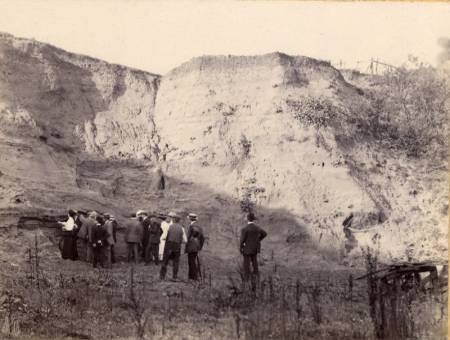
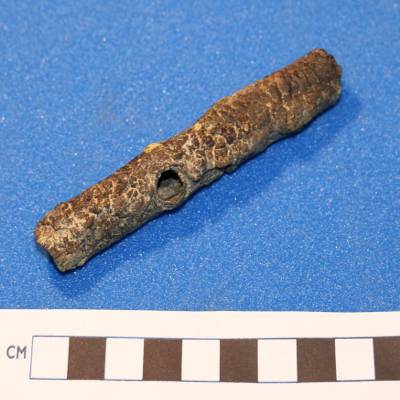 London Clay. Small branch with knot hole, preserved in pyrite. Although this specimen comes from the London Clay Formation in Essex, it was preserved in marine clays having been washed out to sea. These fossils provide the evidence for the vegetaion types which would have grown in north Buckinghamshire during this time.
London Clay. Small branch with knot hole, preserved in pyrite. Although this specimen comes from the London Clay Formation in Essex, it was preserved in marine clays having been washed out to sea. These fossils provide the evidence for the vegetaion types which would have grown in north Buckinghamshire during this time.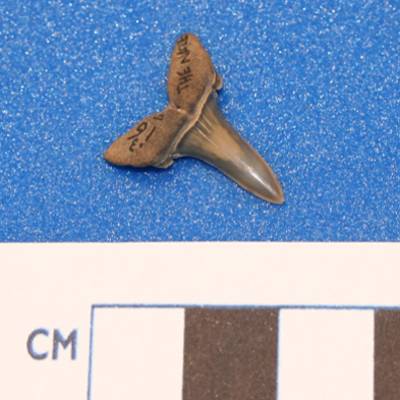 Shark tooth, London Clay. Although this specimen comes from the London Clay Formation in Essex, similar sharks would have swam in the south Bucks during periods of marine transgression.
Shark tooth, London Clay. Although this specimen comes from the London Clay Formation in Essex, similar sharks would have swam in the south Bucks during periods of marine transgression. 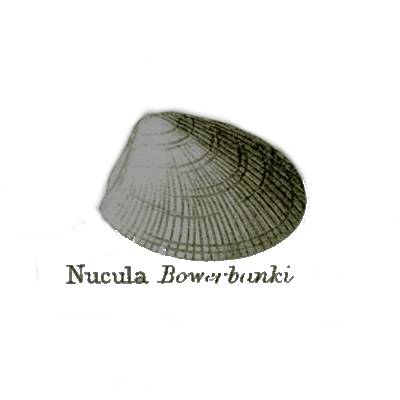 Bivalve Nucula bowerbanki (J. Sowerby). Historically specimens have been recorded as having been collected from the London Clay at Hedgerley, Bucks. Sketch based on Lowry's tabular view of characteristic British fossils.
Bivalve Nucula bowerbanki (J. Sowerby). Historically specimens have been recorded as having been collected from the London Clay at Hedgerley, Bucks. Sketch based on Lowry's tabular view of characteristic British fossils. London Clay Typical lithology of freshly broken unweathered London Clay
London Clay Typical lithology of freshly broken unweathered London Clay![Bivalve Glycimeris [Pectunculus] brevirostris, London Clay Bivalve Glycimeris [Pectunculus] brevirostris, London Clay](images/Lond_Clay_5_Pectunculus.jpg) Bivalve Glycimeris [Pectunculus] brevirostris Historically specimens have been recorded as having been collected from the London Clay at Hedgerley, Bucks. Sketch based on Lowry's tabular view of characteristic British fossils.
Bivalve Glycimeris [Pectunculus] brevirostris Historically specimens have been recorded as having been collected from the London Clay at Hedgerley, Bucks. Sketch based on Lowry's tabular view of characteristic British fossils.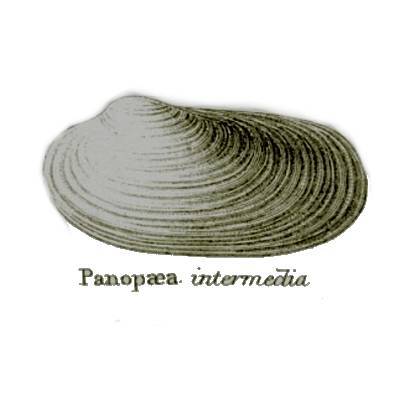 Bivalve Panopaea intermedia Historically specimens have been recorded as having been collected from the London Clay at Hedgerley, Bucks. Sketch based on Lowry's tabular view of characteristic British fossils.
Bivalve Panopaea intermedia Historically specimens have been recorded as having been collected from the London Clay at Hedgerley, Bucks. Sketch based on Lowry's tabular view of characteristic British fossils.